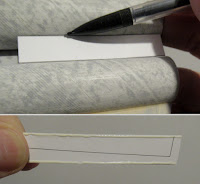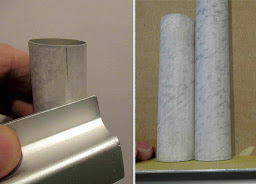I did spray gloss white paint, but with the Florida humidity, most all surfaces came up as a flat finish.
TIP: You can improve the gloss of a flat "humidity" finish with careful use of automotive polishing compound. Use polishing compound - rubbing compound would bee too rough.
Watch your fingernails! They can easily scratch the balsa surfaces. The picture shows the lower half of the upper fin after polishing with some rubbing compound. It's not a full shiny gloss, but enough shine I can accept.
The decals are now available to Patreon supporters as a PDF for home printing. You could print these on self adhesive paper (stickers, like in the original kit) or on water slide decal paper.
Email me at: oddlrockets@bellsouth.net and ask for the Colonial Viper PDF Decals. This decal draw is not an exact copy of the Estes kit decals.
Here's the back end with all the engine decals in place.
Notice the red bars set on the tubes extend and line up with the fin decals. I did go back to the decal draw and make the widths consistent between the pieced decals.
TIP: Set the engine wrap decals first, then match up the red line on the wing decals.
The long red stripe continues down the top of the main body tube and over the nose cone.
This requires a close cut with no clear area over the tube edge and in the nose cone shoulder.
TIP: This is one of the few areas where I use Future clear coat. I only use it to seal the cut edges with a light wipe using a Q-tip.
Even though the canopy decal looks like one full decal,
I'd recommend cutting it into three separate pieces.
Apply the two top windows first, then the two side pairs. Try to get a good white spacing between all the windows.
The rear, top center window was drawn too long. It has been shortened in a decal revision.
Here we go - One of the joys of home print decals.
This area cracked an flaked off when I was trying to slide it around.
I don't know if I'll replace it or not.





















































